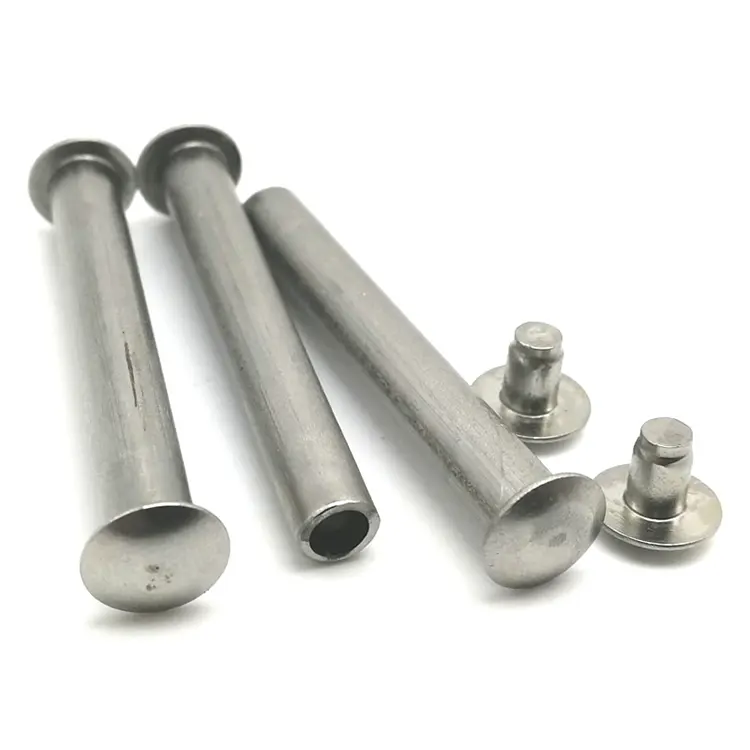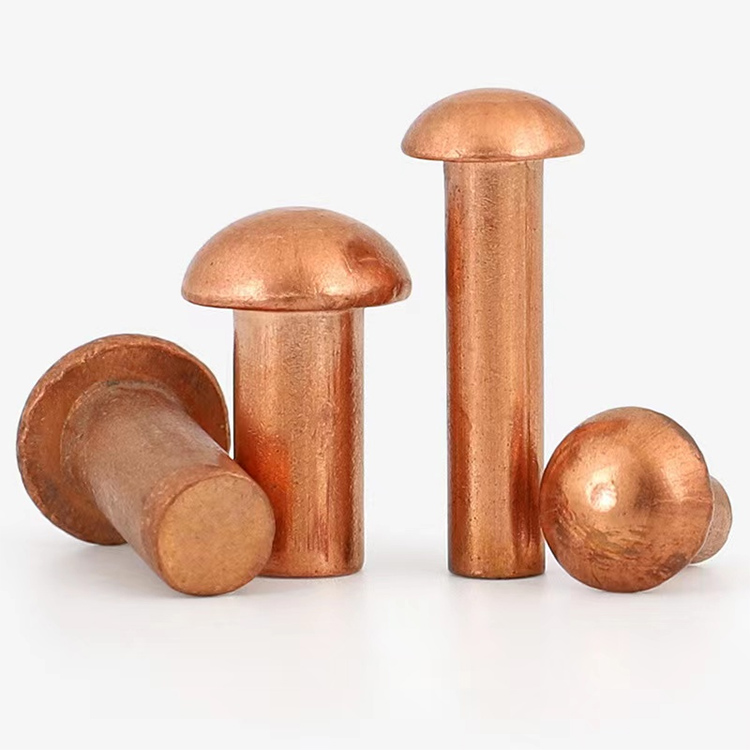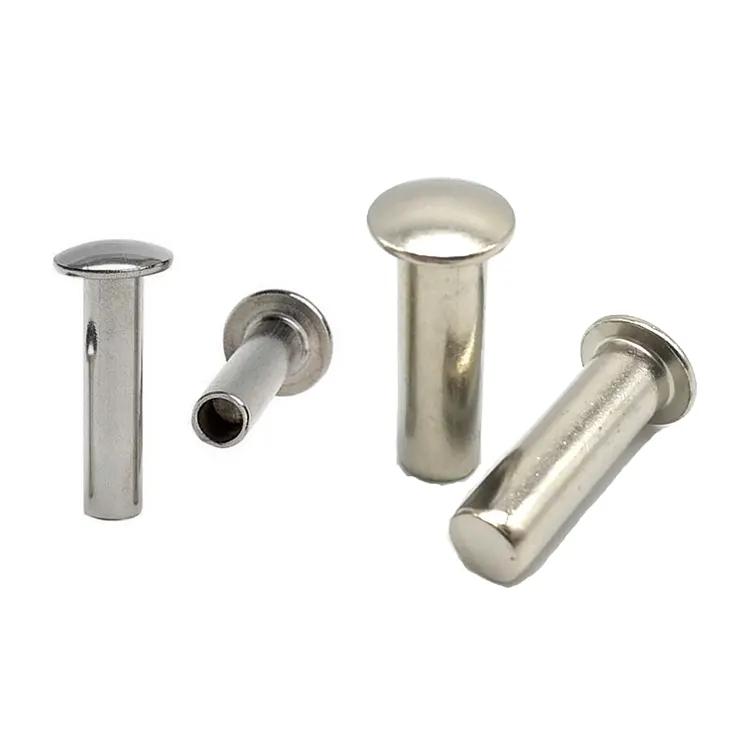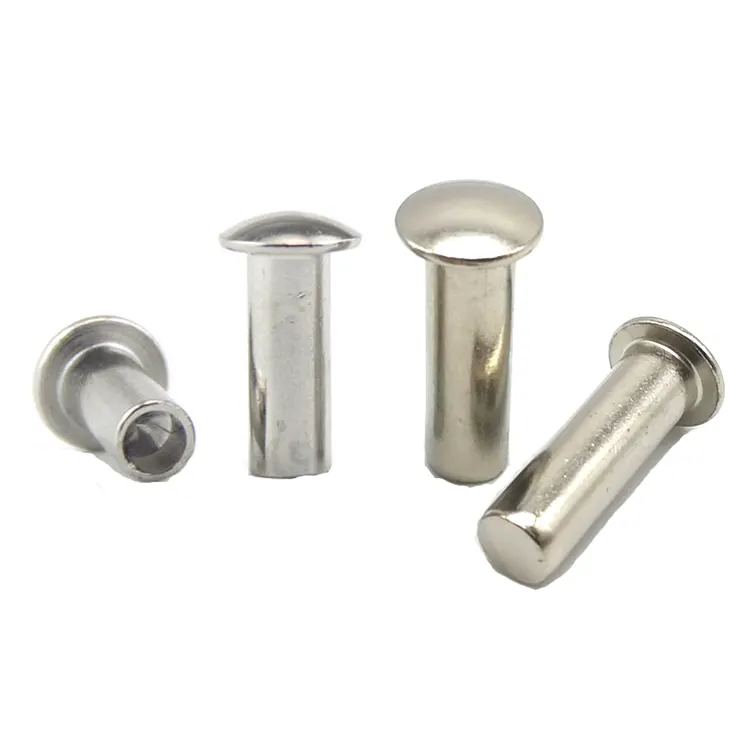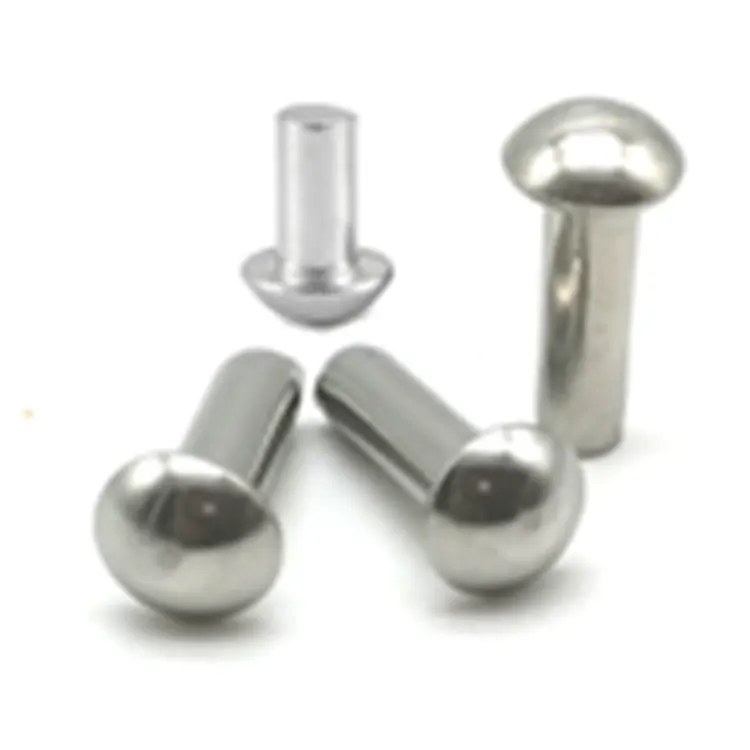Rivets
As one of professional manufacturer in China, Notin would like to provide you Rivets. And we will offer you the best after-sale service and timely delivery.
What is a rivet?
A rivet is a permanent mechanical fastener used to join two or more materials. Rivets work by inserting a metal pin into an aligned hole and deforming the end, creating a strong, secure, and durable connection. Unlike temporary fasteners like screws, rivets do not rely on threads, but instead form a permanent connection, making them ideal for applications requiring high strength, durability, and vibration resistance.
Classification of Rivets
Rivets are typically categorized by head shape, degree of hollowness, or material.
Based on head shape, rivets can be classified as flat head rivets, round head rivets, countersunk head rivets, mushroom head rivets, universal head rivets, truss head rivets, etc.

Based on degree of hollowness, rivets can be classified as solid rivets, semi-tubular rivets, or full tubular rivets.
Based on material, rivets can be classified as brass rivets, stainless steel rivets, steel rivets, aluminum rivets, copper rivets, etc.
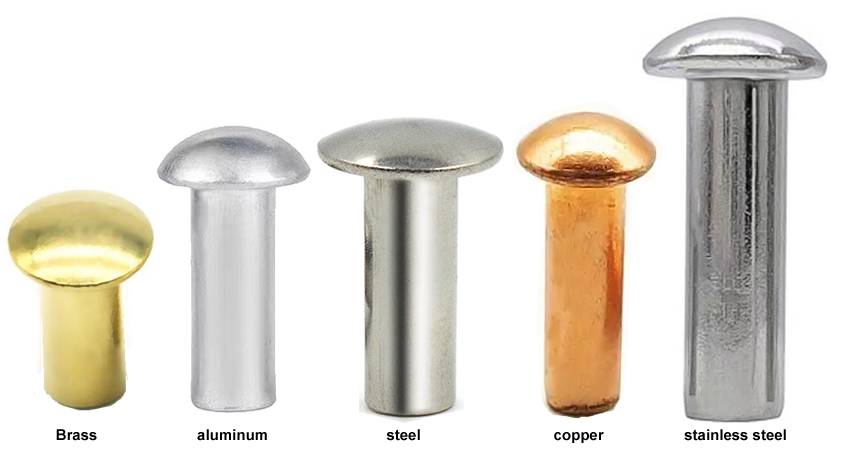
What surface finishes are available for rivets?
Rivet surfaces are typically treated with rust-proofing treatments, primarily electroplating, including zinc plating, nickel plating, chrome plating, tin plating, gold plating, and silver plating. Electroplating is a common rust-proofing method for rivets. It applies a layer of plating to the rivet surface through physical or chemical methods. The plating effectively prevents corrosion and rust, while also providing a certain aesthetic effect.
Another special surface treatment method is head coating. Head coating is performed after the rivet is electroplated. This allows for a variety of colors on the rivet head, achieving an aesthetically pleasing finish.
Aluminum rivets cannot be electroplated, but they can be anodized. Anodizing also allows for a variety of color options, but the unit price is higher than electroplating.
Rust-proofing the rivet surface is crucial, effectively extending the rivet's service life and ensuring a secure connection. Different rust-proofing methods are suitable for different environments and applications, so the choice should be tailored to the specific situation.
- View as
Rivets mâles femelles
Nuote Metals est un fabricant spécialisé de rivets mâles femelles en Chine. Les avantages des rivets mâles femelles sont une installation simple et un faible coût. Comparés à d'autres méthodes de connexion, telles que le soudage ou les adhésifs, les rivets mâles femelles ne nécessitent pas de compétences spécialisées ni de longs temps de durcissement. Cependant, leurs inconvénients sont également importants : la force de connexion est limitée, ce qui la rend inadaptée aux environnements à forte intensité ou à fortes vibrations. Après une utilisation prolongée, ils peuvent se détacher et nécessiter une inspection régulière.
En savoir plusenvoyer une demandeRivets moletés
Les rivets moletés se composent généralement d'une tête, d'une tige et d'une queue. La tige présente un motif moleté diagonal ou droit, une texture usinée en relief qui offre une meilleure adhérence lors de l'installation et empêche le glissement de l'outil. La tige est cylindrique, avec une longueur et un diamètre variant en fonction de l'application. Les tailles courantes vont de 3 mm à 8 mm de diamètre et de 5 mm à 20 mm de longueur. La queue peut également avoir des filetages ou des rainures pour s'accoupler avec des écrous ou d'autres attaches.
En savoir plusenvoyer une demandeRivets à tête ronde en fer
Les rivets à tête ronde en fer sont une fixation largement utilisée dans la fabrication industrielle et dans la vie quotidienne. Leur conception unique et leurs excellentes performances en font un choix de premier ordre dans de nombreux domaines. Nuote Metals est spécialisé dans la production de rivets à tête ronde en fer. Les dimensions de nos rivets respectent strictement les tolérances précisées sur les plans du client. Chaque processus est soumis à un cycle de contrôle qualité pour garantir la qualité du produit final. Nous disposons de dizaines de machines de frappe à froid, avec une production quotidienne de dizaines de millions de rivets.
En savoir plusenvoyer une demandeRivets en fer
Rivets en fer, également appelésrivets en acier au carbone, sont un type de fixation généralement en acier au carbone avec des traitements de surface tels que la galvanisation. Ils offrent une résistance à la traction de 400 à 500 MPa et conviennent aux applications telles que les équipements électriques. Pour s'adapter à diverses applications de rivetage, les rivets en fer sont généralement fabriqués sous forme de rivets semi-creux ou pleins. Les rivets en fer sont un composant mécanique fondamental mais crucial, largement utilisé pour leur résistance, leur prix abordable et leur facilité d'utilisation.
En savoir plusenvoyer une demandeRivets à tête cylindrique en fer
Les rivets à tête cylindrique en fer, avec leurs caractéristiques légères, résistantes à la corrosion et esthétiques, sont devenus des outils polyvalents dans la fabrication industrielle. Que ce soit dans les applications où le poids est critique ou dans la vie quotidienne, les rivets à tête cylindrique en fer offrent des performances et une fiabilité exceptionnelles. Bienvenue chez Nuote Metals à Dongguan, en Chine, spécialiste de ces rivets. Nous proposons des produits de haute qualité avec une livraison garantie. Nous fabriquons également d'autres accessoires de quincaillerie, tels que des œillets, des pièces usinées et des pièces embouties.
En savoir plusenvoyer une demandeRivets à tête de champignon en fer
Nuote Metals est un fabricant professionnel de rivets situé à Dongguan, en Chine. Nos rivets à tête champignon en fer, comme leur nom l'indique, comportent une tête en forme de champignon avec une âme semi-creuse ou pleine. La tête est généralement plus grande, offrant une bonne surface d'appui. Cette structure permet une déformation lors de l'installation, soit par extrusion, soit par un outillage spécialisé, pour relier solidement deux matériaux ou plus. Fabriqués en fer, ils sont généralement galvanisés ou traités avec d'autres finitions pour résister à la corrosion.
En savoir plusenvoyer une demandeWhat are the advantages of rivets over other fasteners?
1. Ease of Installation
Rivets are fast to install, and even fully automated for high-volume applications, resulting in a simple and efficient operation process.
2. Connection Reliability
The riveting process is standardized, with strict quality control, resulting in highly stable connections. Visual inspection allows for quick verification of connection quality.
3. Vibration and Impact Resistance
Rivets connect through deformation or interference fit, providing strong clamping force and excellent vibration resistance, capable of withstanding vibration and shock.
4. Low Cost
Rivets are easy to install and can be fully automated, saving significant labor costs.
What are the advantages and disadvantages of rivets made of different materials?
Aluminum Rivets
Advantages: Lightweight, reduces overall product weight, low cost, suitable for general civilian applications.
Disadvantages: Low tensile and shear strength, unsuitable for high-strength workpieces, prone to electrochemical corrosion when in contact with metals such as stainless steel.
Stainless Steel Rivets
Advantages: Strong corrosion resistance, high hardness, suitable for high-strength workpieces (such as marine equipment)
Disadvantages: Higher cost, typically more expensive than aluminum rivets of the same specification.
Brass and Copper Rivets
Advantages: Excellent conductivity (such as connecting electronic components), good corrosion resistance.
Disadvantages: Higher cost, more difficult to process.
Steel Rivets
Advantages: High hardness, high connection reliability, and wide applicability.
Disadvantages: Compared to other materials, iron rivets are more prone to rusting.
What are the main applications of rivets?
Rivets have a wide range of uses, from small items like a pair of scissors to large items like airplanes and ships, as well as in high-precision medical applications.
Industrial Manufacturing
Rivets are used in a wide variety of industrial fields, wherever there is a need to connect two or more materials.
Electronics
Rivets secure heat sinks and chips, providing both vibration damping and noise reduction, and are widely used in the cooling systems of electronic products such as computers and mobile phones.
Automotive
Rivets are widely used to connect components of automobile bodies and chassis, such as doors and hoods. Their lightweight and corrosion-resistant properties make them an indispensable joining method in automotive manufacturing.
Aerospace
In aircraft manufacturing, rivets are used to connect different fuselage components, such as wings and tailplanes. Millions of rivets create high-strength, corrosion-resistant joints. Aluminum and titanium alloy rivets are often used to connect components of corresponding materials, ensuring stability in extreme environments.
Rivets are used everywhere. The above examples only represent a small number of their applications. We see rivets everywhere in our daily lives, such as on scissors, folding beds, and strollers etc. Rivets can be customized to different sizes and materials depending on the application.
Nuote Metals has specialized in the rivet industry for over a decade. Our factory is located in Dongguan, a city known as the "World Factory," a city with a developed industry and convenient transportation. This allows us to respond quickly when acquiring raw materials and supporting surface treatments, meeting our customers' needs for quick access to samples and bulk orders. We produce 10 million rivets daily and have molds of various specifications, allowing us to produce rivets as small as 0.8mm and as large as 10mm. We welcome your inquiries and visits.

